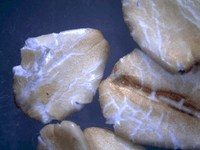Rolled oats
| Nutritional value per 100 g (3.5 oz) | |
|---|---|
| Energy | 379 kcal (1,590 kJ) |
|
67.70 g | |
| Sugars | 0.99 g |
| Dietary fiber | 10.1 g |
|
6.52 g | |
|
13.15 g | |
| Vitamins | Quantity %DV† |
| Vitamin A equiv. |
0% 0 μg |
| Thiamine (B1) |
40% 0.460 mg |
| Riboflavin (B2) |
13% 0.155 mg |
| Niacin (B3) |
8% 1.125 mg |
| Pantothenic acid (B5) |
22% 1.120 mg |
| Vitamin B6 |
8% 0.100 mg |
| Folate (B9) |
8% 32 μg |
| Vitamin B12 |
0% 0.00 μg |
| Choline |
8% 40.4 mg |
| Vitamin C |
0% 0 mg |
| Vitamin D |
0% 0 μg |
| Vitamin E |
3% 0.42 mg |
| Vitamin K |
2% 2.0 μg |
| Minerals | Quantity %DV† |
| Calcium |
5% 52 mg |
| Iron |
33% 4.25 mg |
| Magnesium |
39% 138 mg |
| Manganese |
173% 3.630 mg |
| Phosphorus |
59% 410 mg |
| Potassium |
8% 362 mg |
| Sodium |
0% 6 mg |
| Zinc |
38% 3.64 mg |
| Other constituents | Quantity |
| β-glucan (soluble fibre) | 4 g |
|
| |
| |
|
†Percentages are roughly approximated using US recommendations for adults. Source: USDA Nutrient Database | |
Rolled oats are traditionally oat groats that have been dehusked and steamed, before being rolled into flat flakes under heavy rollers and stabilized by being lightly toasted.
Rolled oats that are sold as porridge oats usually have had the tough bran removed. They have often, but not always, been lightly baked or pressure-cooked or "processed" in some fashion. Thick-rolled oats are large whole flakes, and thin-rolled oats are smaller, fragmented flakes. Oat flakes that are simply rolled whole oats without further processing can be cooked into a porridge and eaten as "old-fashioned" oats, but more highly fragmented and processed rolled oats absorb water much more easily and therefore cook faster into a porridge, so they are sometimes called "quick" or "instant" oats. Rolled oats are most often the main ingredient in granola and muesli.
Rolled oats can be further processed into coarse powder, which, when cooked, becomes a thick broth. Finer oatmeal powder is often used as baby food.
Process
The oat, like other cereals, has a hard, inedible outer husk that must be removed before the grain can be eaten. After the outer husk (or chaff) has been removed from the still bran-covered oat grains, the remainder is called oat groats. Since the bran layer, though nutritious, makes the grains tough to chew and contains an enzyme that can cause the oats to go rancid, raw oat groats are often further steam-treated to soften them for a quicker cooking time (modern "quick oats") and to denature the enzymes for a longer shelf life.[1]
Steel-cut oats
Steel-cut or pinhead oats are oat groats that have been chopped into smaller pieces before any steaming and thus retain bits of the bran layer.
Preparation
Rolled oats can be eaten without further heating or cooking: The oats are soaked for 1–6 hours in water-based liquid, such as water or fruit juice. The soak duration depends on shape, size and pre-processing technique, saving the time and the energy spent on heating, preserving its taste, and saving its nutritional values destroyed during cooking.[2][3]
Traditionally, oat groats are a whole grain that can be used as a breakfast cereal, just like the various forms of oatmeal, rolled oats and pinhead oats can be cooked to make porridge.[4] Rolled oats are used in granola, muesli, oatcakes, and flapjacks.
Nutrients
Whole oats are an excellent source of thiamine, iron, and dietary fiber. Whole oats are also the only source of antioxidant compounds known as avenanthramides; these are believed to have properties which help to protect the circulatory system from arteriosclerosis. Oat products also contain beta-glucan.
See also
References
- ↑ "Types of Oats". The Whole Grain Council. Retrieved 8 April 2016.
- ↑ "Vitamin stability after cooking" (PDF).
- ↑ Alexander, JC. "Toxicity of heated fats". J Toxicol Environ Health. 7: 125–38. doi:10.1080/15287398109529964. PMID 7265292.
- ↑ Cloake, Felicity (10 November 2011). "How to cook perfect porridge" – via The Guardian.

